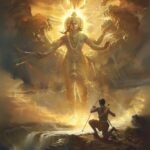What if time isn’t a straight line but a loop, endlessly repeating itself? What if the universe we live in is just one of countless realities, each playing out its own version of existence? These questions, which sound like they belong in a sci-fi movie, have been pondered by ancient civilizations for millennia. From the Hindu concept of cosmic cycles to the Norse myth of Ragnarok and the Mayan Long Count calendar, humanity has long envisioned time as a wheel, not an arrow. Intriguingly, modern physics, with its theories of cyclical universes and multiverses, seems to echo these ancient ideas. Are we on the verge of proving what our ancestors intuited? Let’s dive into the eternal cycle of time, where mythology and science collide.
The Cyclical Nature of Time in Mythology
Time, as we experience it, feels linear: past, present, and future. But many ancient cultures saw time differently, as a circle, endlessly repeating. This cyclical view of time is a cornerstone of Hindu, Norse, and Mayan cosmologies. These civilizations, separated by geography and millennia, arrived at strikingly similar conclusions about the nature of existence. Today, as physicists explore the possibility of cyclical universes and parallel realities, these ancient myths feel eerily prescient.
Hindu Cosmology: The Cosmic Dance of Creation and Destruction
In Hindu philosophy, time is not linear but cyclical, divided into four yugas (ages): Satya Yuga, Treta Yuga, Dvapara Yuga, and Kali Yuga. Together, these four yugas make up one Mahayuga, which lasts 4.32 million years. A thousand Mahayugas form a Kalpa, a single day in the life of Brahma, the creator god. At the end of each Kalpa, the universe is destroyed and reborn, beginning the cycle anew.

This concept of cyclical creation and destruction mirrors modern scientific theories like the Big Bang and the Big Crunch. Physicist Paul Steinhardt, a proponent of the “cyclic model” of the universe, suggests that the cosmos undergoes endless cycles of expansion and contraction. As he puts it, “The universe may have no beginning and no end, just a series of cycles.”
Norse Mythology: Ragnarok and the Rebirth of the World
In Norse mythology, time is also cyclical, culminating in Ragnarok, the apocalyptic battle that destroys the world. But Ragnarok is not the end; it’s a prelude to renewal. After the gods, giants, and monsters perish, the world is reborn, fertile and green, and a new generation of gods emerges.

This idea of destruction leading to rebirth resonates with the scientific concept of entropy and the heat death of the universe. While entropy suggests that the universe is moving toward disorder, some physicists argue that this could be part of a larger cycle. Carl Sagan once said, “The cosmos is all that is or ever was or ever will be.” Could Ragnarok be a metaphor for the universe’s endless dance of death and rebirth?
Mayan Civilization: The Long Count Calendar and the End of Worlds
The Mayans are famous for their Long Count calendar, which tracks vast cycles of time. One such cycle, the b’ak’tun, lasts approximately 394 years. The end of the 13th b’ak’tun in 2012 sparked global speculation about an apocalypse. However, Mayan scholars clarified that this wasn’t the end of time but the end of a cycle—a transition to a new era.

This idea of cyclical transitions aligns with the multiverse theory in physics, which suggests that our universe is just one of many, each with its own timeline and physical laws. As physicist Brian Greene explains, “The multiverse is not just a theory; it’s a prediction of our best theories.” Could the Mayan calendar be hinting at the existence of parallel realities?
Modern Physics: Echoes of Ancient Wisdom?
Modern science is catching up to ancient myths. The cyclic model of the universe, the multiverse theory, and even quantum mechanics suggest that reality is far stranger than we imagine. For instance, the concept of “eternal inflation” proposes that our universe is just one bubble in a vast cosmic foam of universes, each with its own laws of physics.

Moreover, the idea of time as a loop is gaining traction. Physicist Lee Smolin argues that time might be fundamental and cyclical, with each universe giving birth to new ones through black holes. As he writes, “The laws of physics evolve in time, and time is real.”
Open-Ended Debate: Are We Living in a Myth or a Simulation?
The parallels between ancient myths and modern physics raise profound questions. Are these myths merely poetic interpretations of natural phenomena, or do they contain deeper truths about the universe? Could the cyclical nature of time be a fundamental aspect of reality, as both ancient sages and modern scientists suggest?
As we continue to explore the cosmos, we may find that the line between myth and science is thinner than we think. As Neil deGrasse Tyson aptly puts it, “The universe is under no obligation to make sense to you.” Perhaps the eternal cycle of time is one of its greatest mysteries, waiting to be unraveled.
Conclusion: The Timeless Dance of Time
From the Hindu Mahayugas to the Norse Ragnarok and the Mayan Long Count, humanity has long envisioned time as a wheel, endlessly turning. Today, modern physics seems to echo these ancient ideas, suggesting that the universe may be cyclical, infinite, and far more complex than we can imagine. Whether through myth or science, the eternal cycle of time continues to captivate us, reminding us that the universe is a place of endless wonder.














